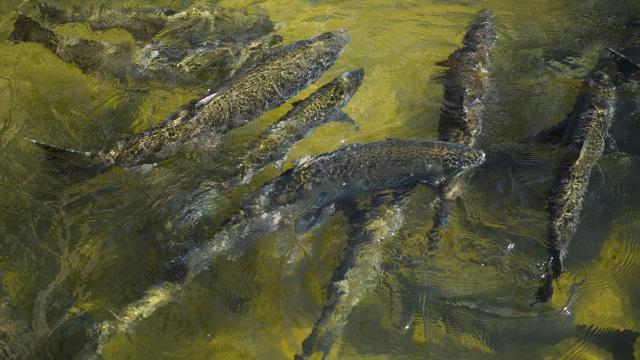Usually, California’s iconic (and endangered) Chinook salmon hatch in freshwater bodies and then swim out to sea for most of their adult lives. But this year, Chinook populations in the state’s Central Valley will be hitching a ride downstream because severe drought conditions have made their traditional path untenable.
Workers at the state’s Department of Fish and Wildlife will load almost 17 million young Chinook salmon from four of their hatching locations in the Central Valley into dozens of climate-controlled tanker trucks. They’ll then drop them off in coastal waters around the San Pablo, San Francisco, Half Moon, and Monterey bays. State estimates show it will take about 146 truckloads carrying 130,000 fish apiece, collectively travelling more than 30,000 miles (48,280 kilometers), to transport all the salmon.
California’s record-breaking hot and dry conditions are leaving lakes and streams unusually shallow and warm, creating less-than-ideal swimming conditions for salmon. Officials hope the plan to drive the fish to cooler bay waters will save them the trouble of migrating, giving them a better chance to survive.
“Trucking young salmon to downstream release sites has proven to be one of the best ways to increase survival to the ocean during dry conditions,” Jason Julienne, the state’s North Central Region Hatchery Supervisor, said in a statement.
California is no stranger to drought, and its Fish and Wildlife Department has driven salmon downstream before. But this year, the heat and dryness are coming on stronger and earlier than usual. This year is the state’s third driest year on record, according to California’s Department of Water Resources. It comes amid what is the driest stretch for the West in more than a millennium, a symptom of a changing climate.
The Fish and Wildlife plan is to transport 20% more salmon around the Central Valley rivers and Delta than in typical years, since it’s looking like without a helping human hand, many fish would die. That would be awful news for the species, since the region’s Chinook species is already endangered due to not only changing climate conditions, but also habitat degradation and disease that’s jumped from farmed Atlantic salmon.
“The California Department of Fish and Wildlife is utilising lessons learned from the past 15 or more years of salmon releases and the last drought to maximise release success,” said Julienne.
Some experts have expressed concern that trucking salmon downstream can rattle them, leaving them in a state of shock that makes them more vulnerable to getting gobbled up by birds and other predators once they’re released back into the wild. But considering their odds of survival aren’t looking so good without this intervention, I’m just going to hope for the best.
